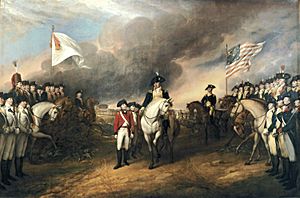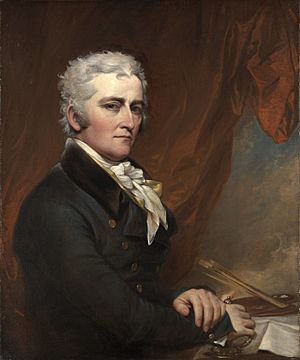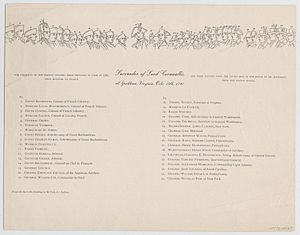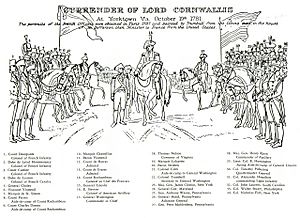Surrender of Lord Cornwallis facts for kids
Quick facts for kids Surrender of Lord Cornwallis |
|
|---|---|
 |
|
| Artist | John Trumbull |
| Year | 1819–1820 |
| Type | Oil painting |
| Dimensions | 3.7 m × 5.5 m (12 ft × 18 ft) |
| Location | United States Capitol rotunda, Washington, D.C. |
| Owner | United States of America |
The Surrender of Lord Cornwallis is a famous oil painting by John Trumbull. He finished the painting in 1820. Today, you can see it in the Rotunda of the United States Capitol building in Washington, D.C..
This painting shows an important moment in American history. It pictures the surrender of British Lieutenant General Charles, Earl Cornwallis. This happened at Yorktown, Virginia, on October 19, 1781. This event ended the Siege of Yorktown. It also helped make sure that America would become an independent country. The painting includes many important American leaders who fought in the siege.
Contents
How the Painting Was Made
Artist John Trumbull's Plan
The artist, John Trumbull (1756–1843), was a soldier at the start of the American Revolutionary War. He worked for famous generals like George Washington. In 1777, he left the army to become an artist.
By 1785, Trumbull began planning a series of large paintings. These paintings would show the most important events of the American Revolution. He traveled to New York City in 1789. There, he drew many important people whose faces he wanted to use in his paintings. In 1791, he even visited Yorktown, Virginia. He sketched the land where the surrender happened.
Congress Orders Paintings
After the War of 1812 ended, Trumbull returned to America. He suggested his idea for the paintings to the United States Congress. Congress was impressed by his work. They had seen his paintings like The Death of General Warren at the Battle of Bunker's Hill, June 17, 1775. They also liked The Death of General Montgomery in the Attack on Quebec, December 31, 1775.
In 1817, Congress decided to order four large paintings from him. These paintings would hang in the United States Capitol rotunda. Each painting cost $8,000. President James Madison chose the size and topics for the paintings.
Completing the Artwork
The paintings would be twelve by eighteen feet (370 cm × 550 cm). The four chosen topics were:
- The Declaration of Independence
- The Surrender of General Burgoyne
- The Surrender of Lord Cornwallis
- General George Washington Resigning His Commission
Trumbull spent the next eight years working on these paintings. He finished Surrender of Lord Cornwallis in 1820. Before it came to Washington, D.C., it was shown in New York City, Boston, and Baltimore. Trumbull himself helped hang it in the Capitol Rotunda in late 1820. It has been there ever since.
Trumbull cleaned and varnished the painting in 1828. It has been cared for many times since then. In 1971, a penny was thrown at the painting and made a hole. This damage was fixed. All the Rotunda paintings were last cleaned in 2008.
What the Painting Shows
The Surrender Scene
This painting shows the surrender of the British army at Yorktown, Virginia. This event happened in 1781. It was the last major battle of the Revolutionary War. The sky in the painting is blue with dark clouds. Broken cannons are also shown. These details suggest the battles that led to this important moment.
In early September, Lord Cornwallis and his 7,000 men were surrounded. He hoped British ships would rescue them from the sea. But a French fleet stopped the British ships in the Battle of the Chesapeake. Within weeks, General Washington brought a much larger army. His cannons attacked the British positions in early October. American and French soldiers then took over two British strongholds. Cornwallis surrendered on October 19, 1781.
Key Figures in the Painting
In the middle of the painting, American General Benjamin Lincoln is on a white horse. He holds out his right hand. He is reaching for the sword of the surrendering British officer, General Charles O'Hara. General O'Hara leads a long line of British soldiers that goes into the background.
On the left side, French officers are standing and on horseback. They are under the white flag of the French royal family. On the right side are American officers under the Stars and Stripes flag. Among them are the Marquis de Lafayette and Colonel Jonathan Trumbull. Colonel Trumbull was the painter's brother.
General George Washington is on a brown horse. He stays in the background. This is because Lord Cornwallis himself was not there for the surrender. The Comte de Rochambeau is on the left-center, also on a brown horse.




